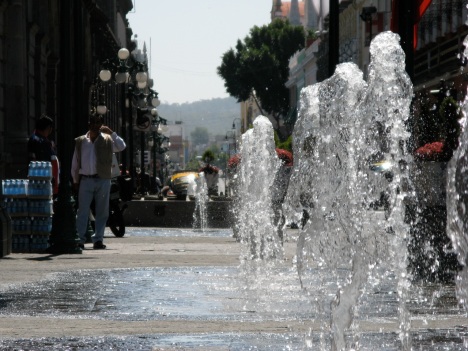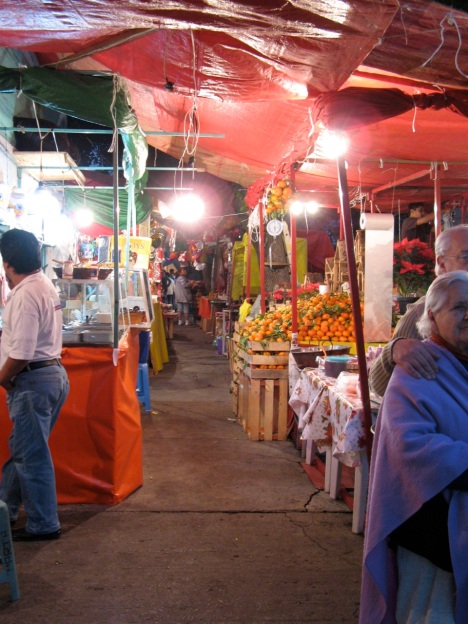
Fountains on the zocalo
Original post: In Pictures: Puebla, Mexico
Location: Puebla, Puebla
Filed under: * Favorite Pictures | Tagged: * Favorite Pictures, fountains, Puebla, Zocalo | Leave a comment »

Fountains on the zocalo
Original post: In Pictures: Puebla, Mexico
Location: Puebla, Puebla
Filed under: * Favorite Pictures | Tagged: * Favorite Pictures, fountains, Puebla, Zocalo | Leave a comment »
Puebla is a “town” of nearly 1.5 million people, the 4th largest in Mexico, and almost exactly two hours by bus from the Districto Federal. Though the local poblanos may take more pride in their cuisine, the first thing that tourists are likely to notice is the number of churches… and the second is the architecture.

Fountains on the zocalo
A trip there last week for a conference (also the reason for the lack of recent posts, more in a couple of days) provided the opportunity to take a few pictures.
México, D.F.
Filed under: Mike's Notes on Mexico: Places and Peoples | Tagged: Churches, Mexico, Puebla, Zocalo | 1 Comment »
Near the zócalo, the center of México, D.F., there’s a long underground passageway full of… bookstores. To find the passage, which continues for seven blocks, it is necessary to enter through one of the two metro stations that it connects, Pino Suarez and Zócalo, or to find one of the very few street-level entrances along Calle José María Pino Suarez (map). In fact, it seems reasonable to believe that the passageway, or el pasillo de librerías, is a secret, as the signs to the passageway are often hidden or non-existent.

...seven blocks of underground bookstores...
The passage, itself, is a 70’s-style, concrete and linoleum, and mildly claustrophobic tunnel lined on alternating sides by booksellers. Unlike many of the informal markets in Mexico City, where (often illegally-printed) books wrapped in plastic are laid out on a blanket on the ground, these librerías are constructed — rooms with doors, fluorescent lighting, and glass walls — and they often specialize in a particular type of book. There’s a store that focuses on books to learn english, another on health, and even one that specializes in comics.
On rare occasions, often by accident, I have found myself down in the passage, pondering the vast collection of literature for sale. Given the noise and chaos of the street, it feels as if the pasillo could just as easily be on Mars as downtown Mexico City.
Berkeley, CA
Filed under: Mike's Notes on Mexico: Places and Peoples | Tagged: books, bookstores, mexican markets, Mexico City, mexico city metro, pasillo de librerías, Pino Suarez, underground passageways, Zocalo | Leave a comment »
I must admit that, after having become accustomed to the the widespread gaudiness (of course, it is a matter of opinion!) of decoration in Mexico, I expected the Christmas season to bring some truly spectacularly kitschy public displays. After all, back home in the states, people seem to revel in the “spirit” of the holidays, with entire neighborhoods lathering sheets of blinking lights, monument-sized, air-filled, blowing snow globes, and six-foot, animated, plastic reindeer.
But here in México, D.F., it almost seemed as if, given my expectations, that holiday decoration was, well, tasteful. Most buildings had (relatively) little external decoration, with most of the effort spent on decorating trees placed in living rooms and expansive nativity scenes, proudly displayed on fireplace mantles. That’s not to say that there weren’t hordes of little robotic singing Santa figures for sale at local markets and plenty of evidence of the holiday’s commercialization… but the general absence of glaring lights and gaudy lawn displays seemed to make the holiday and the “holiday spirit” feel, well, more genuine.
One of the most festive parts of the holiday are seasonal markets that spring up on street corners and, especially, around the permanent neighborhood markets in the center of many of the colonias.

...dozens of holiday stalls filled the porticos around the market in Escandón....
The market in Escandón seemed to double in size, as perhaps three or four dozen stalls opened up under the porticos along José Martí, selling everything from warm ponche, fried potatoes and plantains, and the more ubiquitous quesadillas, tortas, and tacos to gifts, wrapping paper, and Christmas trees. Some of the more interesting stalls sold supplies for nativity scenes, with little figurines, toy ceramic houses, and sheets of various dried mosses and lichens that are used to landscape the scenes.
In the center of the city, the zócalo was also dressed for the holidays, with large scaffolds of lights covering the government buildings surrounding the plaza, a huge decorative tree, and interactive displays and rides… even a sledding hill and an ice rink. In the afternoons and evenings, the zócalo would fill with people coming to experience the spectacle, festive crowds adding to the energy of the moment.
México, D.F.
Filed under: Mike's Notes on Mexico: Places and Peoples | Tagged: Christmas, holiday decorations, holiday spirit, Mexican Christmas, mexican markets, Mexico City, nativity scenes, Zocalo | Leave a comment »
This weekend, México celebrated Día de los Muertos, a festival in which people offer food, flowers, and ornamental alters for the departed. This holiday is steeped with stories and tradition — on Saturday evening, I met a few Fulbrighters downtown to hear a few legends and then take in the sights. Decorated in honor of the holiday with ofrendas from many local delegaciones and companies, the zócalo was an energetic hub of music, dancing, crowds, and color. Though, perhaps this story is better told in pictures…..
México, D.F.
Filed under: Mike's Notes on Mexico: Places and Peoples | Tagged: Dia de los Muertos, festivals, In Pictures, Mexico City, Zocalo | 1 Comment »